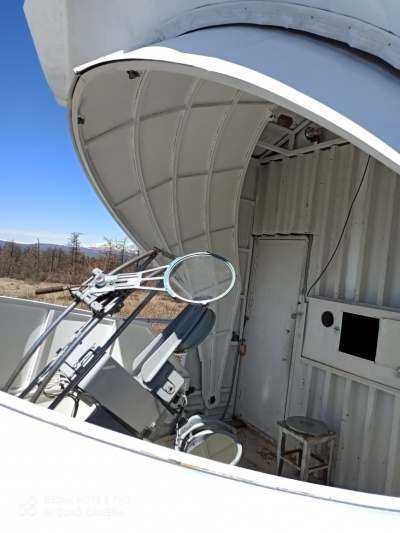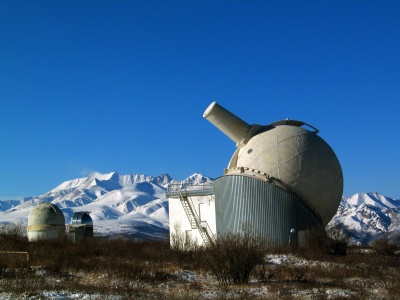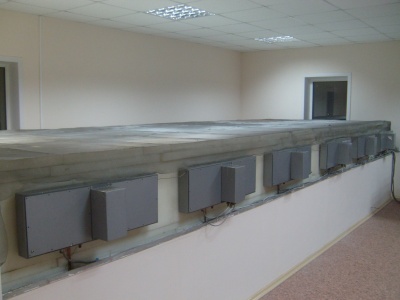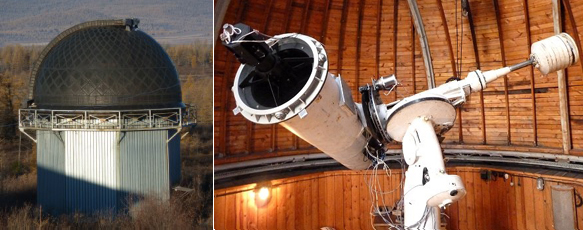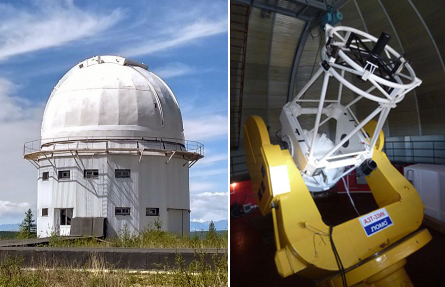Institute of Solar-Terrestrial Physics of Siberian Branch of Russian Academy of Sciences (ISTP SB RAS)
Sayan Solar Observatory
From ISTP SB RAS
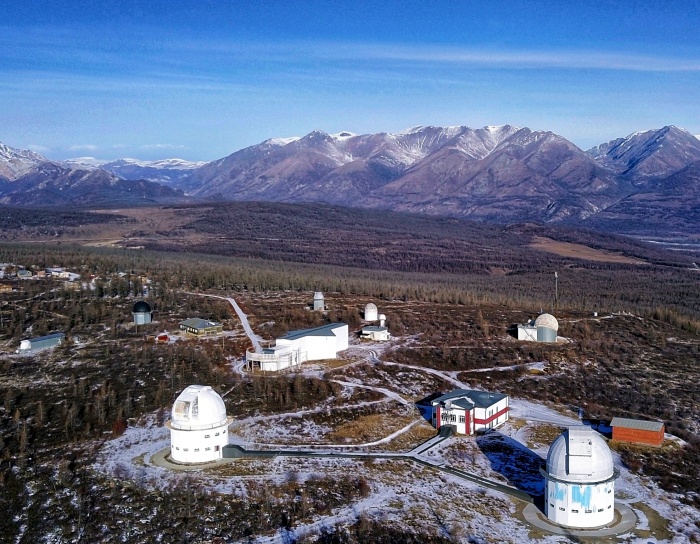
Located near the Settlement of Mondy (Buryatia), 320 km from Irkutsk in mountains at the 2000-m altitude, the Sayan Solar Observatory is among the facilities known worldwide (Obs. Code C48). The Observatory site survey was caused by the Mission specifics demanding a high transparence of the Earth atmosphere for polarization measurements and observations of the solar corona.
[edit] Instruments
- Horizontal Solar Telescope
- Solar Telescope for Real-Time Forecasts
- Lyot Coronagraph
- Spectrographic Suite to Measure Cosmic Rays
- Astronomical Suite
[edit] Solar Telescopes
Mission
- Measuring solar magnetic fields
- Spectral and filter observations of solar active formations and dynamic processes in the solar atmosphere
[edit] Universal Automated Solar Telescope (AST) with a suite of magnetographs and spectro-photometers
Specifications:
0.8-m mirror with the 20-m focal length;
7-m focal length spectrograph;
200×300-mm 600 gr/mm grating.
Equipment: vector magnetograph, spectro-polarimeter
The Horizontal Solar Telescope includes a ceolostat, a system comprising two flat 0.8-m mirrors that enables to continuously trace the Sun. The coelostat directs the sunlight onto the main spherical 0.8-m mirror with the 20-m focal length. The mirror creates the Sun image on the spectrograph slit and on the photoguide. At good atmospheric conditions, the spatial resolution is around 1 arcsec. The Automated Control System (ACS) enables to control the telescope and to set the necessary observational parameters. The telescope is equipped with a solar magnetograph to measure magnetic fields and plasma traveling velocity in the solar atmosphere and to record their temporal variations.
At the test stage, a new spectro-polarimeter to measure solar magnetic fields and radial velocities in active regions is under operation. The program system to process the spectro-polarimeter data, as well as the graphic interface was developed to calculate Stokes profiles and to create maps for the Stokes parameters in real time. While improving the accessory equipment for the telescope and research methods, more than 30 inventions were made.
The AST is on the list of the world major solar telescopes.
Most important AST-obtained results
For the first time, researchers obtained a detailed pattern of the magnetic field emergence in an active region from Sun sublayers onto the surface. Revealed were new regularities of the magnetic field structure and of its dynamics at various stages of the active region evolution. The active region magnetic flux was shown not to completely dissipate during its evolution or escape the Sun, but its part plunges back into Sun sublayers. Discovered were special features of convective motions in an active region: ring convective structures around a sunspot, whose interaction with the magnetic field determines the stability of sunspots, their evolution and lifetime. A large volume of H and K Ca II spectral observations of the sunspot chromosphere is used to create a self-consistent model for the umbra chromosphere. Studying variations in the "umbral flare" intensity, comparing the magnetic density to flux density of chromospheric emission indicate the source of active chromosphere heating: it is an MHD-wave slow magnetoacoustic mode. Temporal variations in the H and K profiles show that "the umbral flare" process encompasses the solar atmosphere from the temperature minimum to the mid chromosphere. Traveling waves in the umbral chromosphere were detected experimentally. Apparent horizontal propagation of those waves (as well as penumbral traveling waves) is shown to be a consequence of the axisymmetric inclination of magnetic field lines in a sunspot. Studying the structure of the magnetic field and currents in sunspots evidences the existence of two subsystems of the magnetic field inside a sunspot penumbra. Found were sunspot torsional vibrations at the photospheric level with an ~20-min period and variations in the Evershed effect maximal velocities with periods of 20-100 minutes. Torsional vibrations and variations in Evershed motion radial velocity are elucidated as a response of the entire sunspot to an outer disturbance. For the first time, detected were long-period (40-80 min) variations in the Doppler velocity in prominences and filaments. Studied were characteristics of oscillations in quiet and pre-eruptive filaments. A bulk of multilevel studies of oscillatory modes in facular active regions and coronal holes was performed. Shown was their important role in the energy exchange between the solar atmosphere layers.
[edit] Problem-Oriented Solar Telescope for Real-Time Forecasts (Solar Telescope for Operative Predictions - STOP) to measure weak background magnetic fields and the magnetic field of the Sun as a star
Specifications:
Jensch-ceolostat with 0.3-m mirrors;
200-mm two-lens objective with the 5-m focal length;
scanning photoguide;
Littrow spectrograph with the 5-m focal length and the 200x300-mm, 600 gr/mm grating.
Observations at different spatial (angular) resolution are provided by moving the objective and photoguide along the optical bench.
Equipment: longitudinal field spectro-magnetograph.
The Solar Telescope for Real-Time Forecasts was designed to measure the magnetic field of the Sun as a star and weak large-scale magnetic fields (LSMF) throughout the entire disk simultaneously in several spectral lines. The solar magnetic field is known to elongate by the solar wind into the interplanetary space (from coronal holes) and our Earth is inside the heliosphere and is subject to the effects of the solar wind and of the interplanetary magnetic field. By measuring the magnetic field distribution on the Earth surface, we can determine (based on empirical regularities and theoretical models) the magnetic field and the solar wind parameters in the Earth orbit and use that information to forecast geomagnetic disturbances. It is the STOP that was designed to solve such kind of applied problems. Besides, the synoptic information on the magnetic field of the Sun as a star and its distribution throughout the Sun surface may help solve fundamental issues of the solar dynamo and of the Sun variability on different timescales.
LSMF Stokes-meter measurements enable to solve a wide range of physical problems in studying the nature of solar magnetic fields and methods to forecast the heliospheric parameters.
[edit] Large Lyot Solar Coronagraph
Specifications:
Nikol'skiy telescope with a 535-mm one-lens objective and 12-m focal length.
Equipment: spectrograph with the 8-m focal distance and the 300×300-mm grating.
The Lyot coronagraph at the Sayan Observatory is one of the world's largest. It is intended to study the corona beyond eclipses and the chromosphere with very low parasitic scattered light. The coronagraph is equipped with a spectrograph and narrow-band filters. In recent years, this instrument enabled to do a number of investigations into the dynamics of chromospheric spicules - fine-structure plasma ejections into the Sun chromosphere and corona. Detected were new regularities in the dynamic properties of spicules and their variations. This new knowledge enabled to near solving the mechanism for heating the solar corona - the outer solar atmosphere heated up to 1.000.000 K, whereas the visible surface of the Sun is about 6.000 K.
[edit] ISTP SB RAS Sayan Spectrographic Suite to Measure Cosmic Rays
Mission: monitoring the radiation and electromagnetic conditions in the space.
Characteristics and equipment: the Sayan mountain spectrographic suite comprises three automatic stations of the cosmic rays located at different altitudes: 475 m (IRKUTSK), 2000 m (IRKUTSK-2), and 3000 m (IRKUTSK-3) above sea level. They are equipped with neutron supermonitors: 18-NM-64, 12-NM-64, and 6-NM-64, respectively. The spectral response range varies 3 to 30-50 GeV. The statistical observational accuracy over an accumulation hour is 0.1 %.
IRKUTSK Continuous observations of the neutron component were started in the Settlement of Zuy in 1956. In 1998, the station was removed to Irkutsk, into a pavilion within ISTP SB RAS. The IRKUTSK data: hour and minute values for the neutron component intensity, non-corrected, corrected for pressure, real-time pressure values.
IRKUTSK-2 The IRKUTSK-2 data: hour and minute values for the neutron component intensity, non-corrected, corrected for pressure, real-time pressure values.
IRKUTSK-3 The IRKUTSK-3 data: hour and minute values for the neutron component intensity, non-corrected, corrected for pressure, real-time pressure values.
ISTP SB RAS СR data, accessible to users:
| CR Stations | IRKUTSK | IRKUTSK-2 | IRKUTSK-3 |
| 1-min resolution | since 2000 | since 2009 | since 2009 |
| hour resolution | since 1958 | since 1981 | since 1981 |
The Sayan spectrographic suite to measure cosmic rays is a highland suite in Russia. Using its data with the worldwide network of neutron monitors enables to distinguish the cosmic-ray effects between the effects of magnetospheric and interplanetary origins, to study the cosmic-ray intensity distribution over the celestial sphere within separate energy intervals, to investigate variations in the anisotropy and in the energy spectrum of galactic and solar cosmic rays, and, based on this, to diagnose electromagnetic and radiation conditions in the interplanetary space.
[edit] Astronomic SUITE of Sayan Solar Observatory
The suite of star telescopes has been formed to study objects in the near-Earth space.
[edit] Upgraded AZT-14 Telescope
Automated telescope on the APSh-6 mount, with a 48-cm main mirror. The lens proofer installed in the primary focus enables to obtain the 2-deg field of view. The equivalent focal length is 1.2 m. The telescope conducts regular observations to search for space-debris objects and calculate their trajectories in the near-Earth space.
[edit] AZT-33 Telescopes
The AZT-33IK infrared telescope: a Ritchey-Chrétien system, 1.6-m main mirror, 30-m focal length, 12-ang.min field of view. The telescope design is optimized to observe in the IR. The telescope possesses the optical system of visible band with the focal length reducer (f/4.4) and the 8x7 ang.min field of view, photometric and spectroscopic hardware. The telescope is intended to measure photometric and spectral characteristics of various space objects in the optical and IR spectra. At the АZТ-33IK, one can take photometric measurements of space debris objects in the near-Earth space, optical afterglows of gamma-ray bursts, photometric and spectroscopic measurements of quasars, active galactic nuclei, clusters of galaxies and other objects. Also, it operates within the ground-based support for the "Spektr-RG" X-ray space observatory.
The АZТ-33VМ is a wide-angle telescope with the <3-deg field of view. A modified Ritchey-Chrétien system with the pre-focal adjuster, 1.6-m main mirror, the 5.6-m focal length. The telescope conducts high-speed reviews of the sky equatorial region to detect and catalog high-apogee space objects, as well as to search for, detect and measure (at limiting ranges) the characteristics of unknown and dangerous space objects (asteroids and comets) nearing the Earth.
- This page has been accessed 26,159 times.

